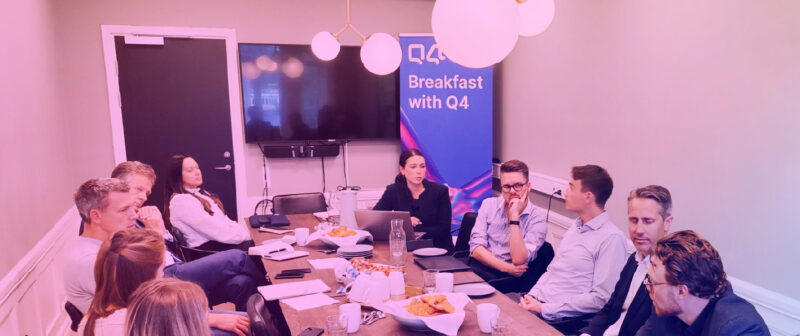On September 29th, in Copenhagen, Q4 hosted a breakfast meeting with investor relations professionals to discuss best practices when targeting investors.
Investor Relations (IR) teams across the Nordics acknowledge the need for targeted investor outreach. Participants in the breakfast meeting agreed that investor targeting enables IR teams to validate broker recommendations; and become more discerning about the meetings they choose to attend.
Additionally, some participants had found that targeting had helped remediate misalignment in the shareholder base, and discrepancies in valuation compared to peers.
It was noted, that a well-aligned valuation is crucial, as it affects the company’s ability to use shares as currency and impacts the cost of capital. Here, the fundamental metric to address is the gap from Fair Market Value.
What type of investors am I looking for?
Targeting can also help mitigate the risk of significant price reactions due to top holders trimming positions. It was agreed that IR teams should maintain an evolving pipeline of potential shareholders, and keep a meticulous eye on the company’s long-term vision, assessing whether it aligns with potential investors’ expectations.
It is therefore essential to target investors that are willing to take a long-term view – these shareholders will show support when times are challenging.
Market perception and realistic targets
Understanding how the market perceives your company is vital. Participants had experienced that broker feedback following investor meetings was often delayed and lacked detail. In order to tackle this head on, it was suggested that time should be allocated at the end of each meeting in order to facilitate direct feedback.
Outside of this, there was a broad consensus that a perception study could be an excellent feedback tool, it is widely used to inform future investor outreach, and can also the subject matter and structure of upcoming events.
Measurement of success
The ROI of investor targeting can be measured through any number of metrics, these include: level of engagement; understanding of the company’s story; quality of feedback received; and the actual purchase of shares. However, it is critical to define what success looks like in advance and measure performance against these metrics on an ongoing basis.
Finding the right peers
Identifying an adequate peer group remains a significant challenge for some companies. It was therefore crucial for these companies to identify key value drivers in order to identify a broader, thematic and fundamental peer group – this is becoming increasingly common practice.
Participants confirmed that by looking at non-traditional peers, often beyond their core markets, they had been able to identify investors that were looking for exposure to new geographies or sectors, and these investors were sometimes willing to own the company at a premium.
The symbiotic role between sell-side and corporates
While effective investor targeting can lead to higher quality meetings, it was also widely acknowledged that maintaining a symbiotic relationship with brokers is essential. It often requires putting effort into broker relationships and giving them access to management more than you might need to. Participants agreed that ‘readover meetings’ – where investors review the peer group in order to get a better sense of the industry – should be accepted. This relationship enables companies to ensure they are being talked about.
It was the group’s experience that while brokers tend to be open about their relative strengths and weaknesses you should measure and report on their performance – often it is a case of trial and error.
Building quality relationships
Choosing who to speak to is crucial. I was suggested that direct communication with sales desks could lead to new opportunities. Spending time with analysts and sales teams in person is essential to impart industry knowledge and get them talking about your company with investors.
Understanding cultural differences
Understanding cultural nuances and tailoring your pitch accordingly is critical when approaching investors. For example, while US corporations might adopt a more aggressive selling approach, Danish companies prefer a more reserved tone. Adjusting your presentation and the type of intel offered based on the audience is essential.
Conclusion
The roundtable emphasized the need for clear objectives, strategic alignment, and cultural understanding. It underscored the value of symbiotic relationships with brokers and the importance of nuanced communication with potential investors. By adopting a more targeted and thoughtful approach, IR teams can optimize their outreach efforts and significantly impact their companies’ growth trajectories.


